HNN320: Strategies for Leadership and Clinical Governance Report
VerifiedAdded on 2023/01/23
|13
|3795
|99
Report
AI Summary
This report addresses the critical issue of hospital-acquired infections (HAIs) within a healthcare setting, focusing on the role of leadership and clinical governance in mitigation strategies. The report begins by emphasizing the importance of leadership and clinical governance in ensuring safe and high-quality healthcare services, setting the stage for a discussion on reducing HAIs. Two key strategies are explored: promoting hand hygiene and implementing the effective use of disinfectants. The report details how educating patients and nurses about the significance of hand hygiene can significantly reduce the transmission of pathogens, supported by existing evidence and practical implementation methods. It discusses the obstacles that may hinder the implementation of these strategies, such as beliefs, attitudes, and resource limitations, while also highlighting facilitators like water supply and continuous training. The second strategy, the use of disinfectants, explores the role of nurses in ensuring a clean environment and the implementation of modern technologies like self-disinfecting surfaces. It also considers the barriers to disinfectant implementation, such as cost and potential health risks, while identifying factors that can facilitate their effective use. Finally, the report emphasizes the role of clinical governance in addressing barriers, enhancing facilitators, and ensuring the successful implementation of the discussed strategies to improve patient outcomes. This comprehensive analysis provides valuable insights into the complexities of infection control and the vital role of leadership and governance in healthcare.
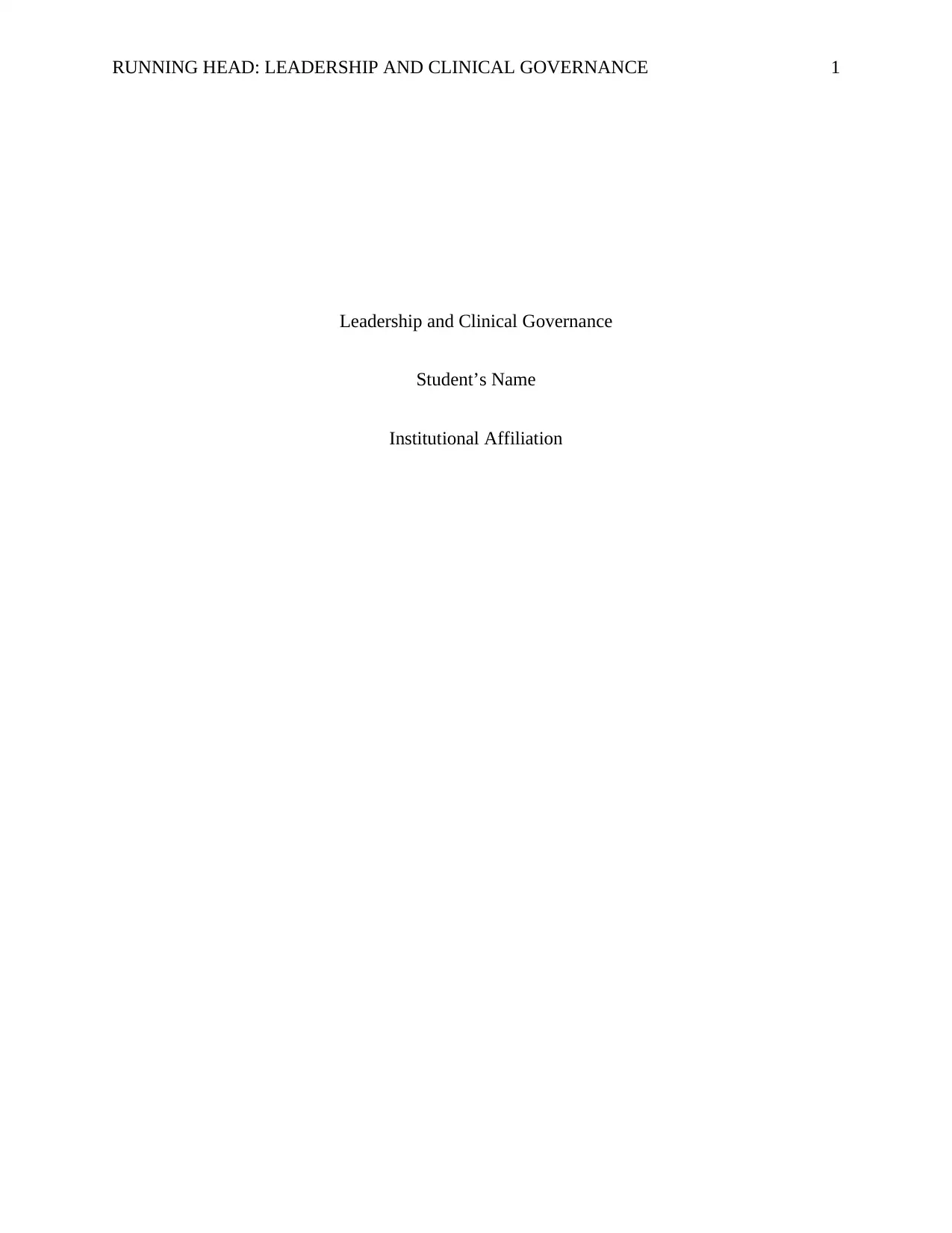
RUNNING HEAD: LEADERSHIP AND CLINICAL GOVERNANCE 1
Leadership and Clinical Governance
Student’s Name
Institutional Affiliation
Leadership and Clinical Governance
Student’s Name
Institutional Affiliation
Paraphrase This Document
Need a fresh take? Get an instant paraphrase of this document with our AI Paraphraser
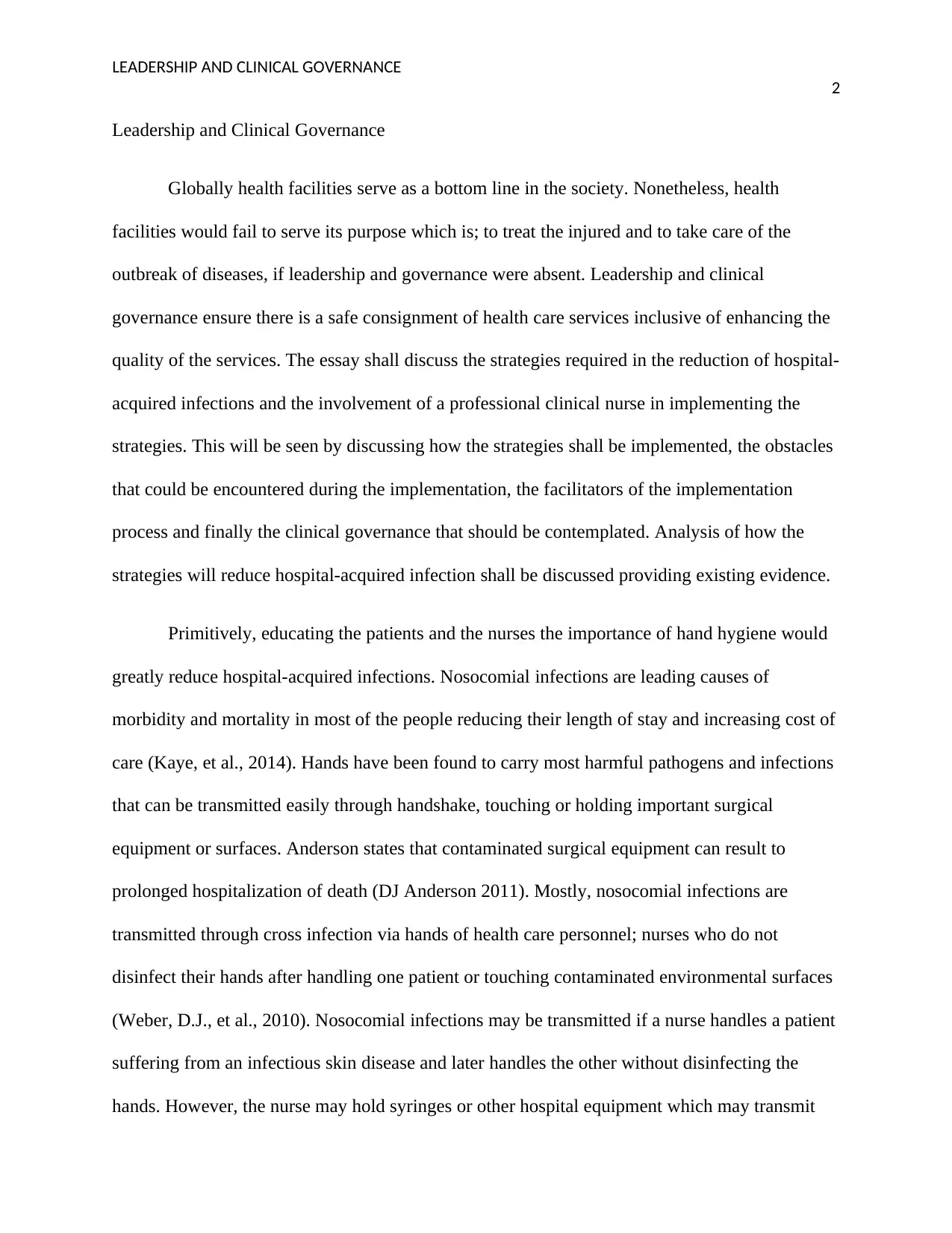
LEADERSHIP AND CLINICAL GOVERNANCE
2
Leadership and Clinical Governance
Globally health facilities serve as a bottom line in the society. Nonetheless, health
facilities would fail to serve its purpose which is; to treat the injured and to take care of the
outbreak of diseases, if leadership and governance were absent. Leadership and clinical
governance ensure there is a safe consignment of health care services inclusive of enhancing the
quality of the services. The essay shall discuss the strategies required in the reduction of hospital-
acquired infections and the involvement of a professional clinical nurse in implementing the
strategies. This will be seen by discussing how the strategies shall be implemented, the obstacles
that could be encountered during the implementation, the facilitators of the implementation
process and finally the clinical governance that should be contemplated. Analysis of how the
strategies will reduce hospital-acquired infection shall be discussed providing existing evidence.
Primitively, educating the patients and the nurses the importance of hand hygiene would
greatly reduce hospital-acquired infections. Nosocomial infections are leading causes of
morbidity and mortality in most of the people reducing their length of stay and increasing cost of
care (Kaye, et al., 2014). Hands have been found to carry most harmful pathogens and infections
that can be transmitted easily through handshake, touching or holding important surgical
equipment or surfaces. Anderson states that contaminated surgical equipment can result to
prolonged hospitalization of death (DJ Anderson 2011). Mostly, nosocomial infections are
transmitted through cross infection via hands of health care personnel; nurses who do not
disinfect their hands after handling one patient or touching contaminated environmental surfaces
(Weber, D.J., et al., 2010). Nosocomial infections may be transmitted if a nurse handles a patient
suffering from an infectious skin disease and later handles the other without disinfecting the
hands. However, the nurse may hold syringes or other hospital equipment which may transmit
2
Leadership and Clinical Governance
Globally health facilities serve as a bottom line in the society. Nonetheless, health
facilities would fail to serve its purpose which is; to treat the injured and to take care of the
outbreak of diseases, if leadership and governance were absent. Leadership and clinical
governance ensure there is a safe consignment of health care services inclusive of enhancing the
quality of the services. The essay shall discuss the strategies required in the reduction of hospital-
acquired infections and the involvement of a professional clinical nurse in implementing the
strategies. This will be seen by discussing how the strategies shall be implemented, the obstacles
that could be encountered during the implementation, the facilitators of the implementation
process and finally the clinical governance that should be contemplated. Analysis of how the
strategies will reduce hospital-acquired infection shall be discussed providing existing evidence.
Primitively, educating the patients and the nurses the importance of hand hygiene would
greatly reduce hospital-acquired infections. Nosocomial infections are leading causes of
morbidity and mortality in most of the people reducing their length of stay and increasing cost of
care (Kaye, et al., 2014). Hands have been found to carry most harmful pathogens and infections
that can be transmitted easily through handshake, touching or holding important surgical
equipment or surfaces. Anderson states that contaminated surgical equipment can result to
prolonged hospitalization of death (DJ Anderson 2011). Mostly, nosocomial infections are
transmitted through cross infection via hands of health care personnel; nurses who do not
disinfect their hands after handling one patient or touching contaminated environmental surfaces
(Weber, D.J., et al., 2010). Nosocomial infections may be transmitted if a nurse handles a patient
suffering from an infectious skin disease and later handles the other without disinfecting the
hands. However, the nurse may hold syringes or other hospital equipment which may transmit
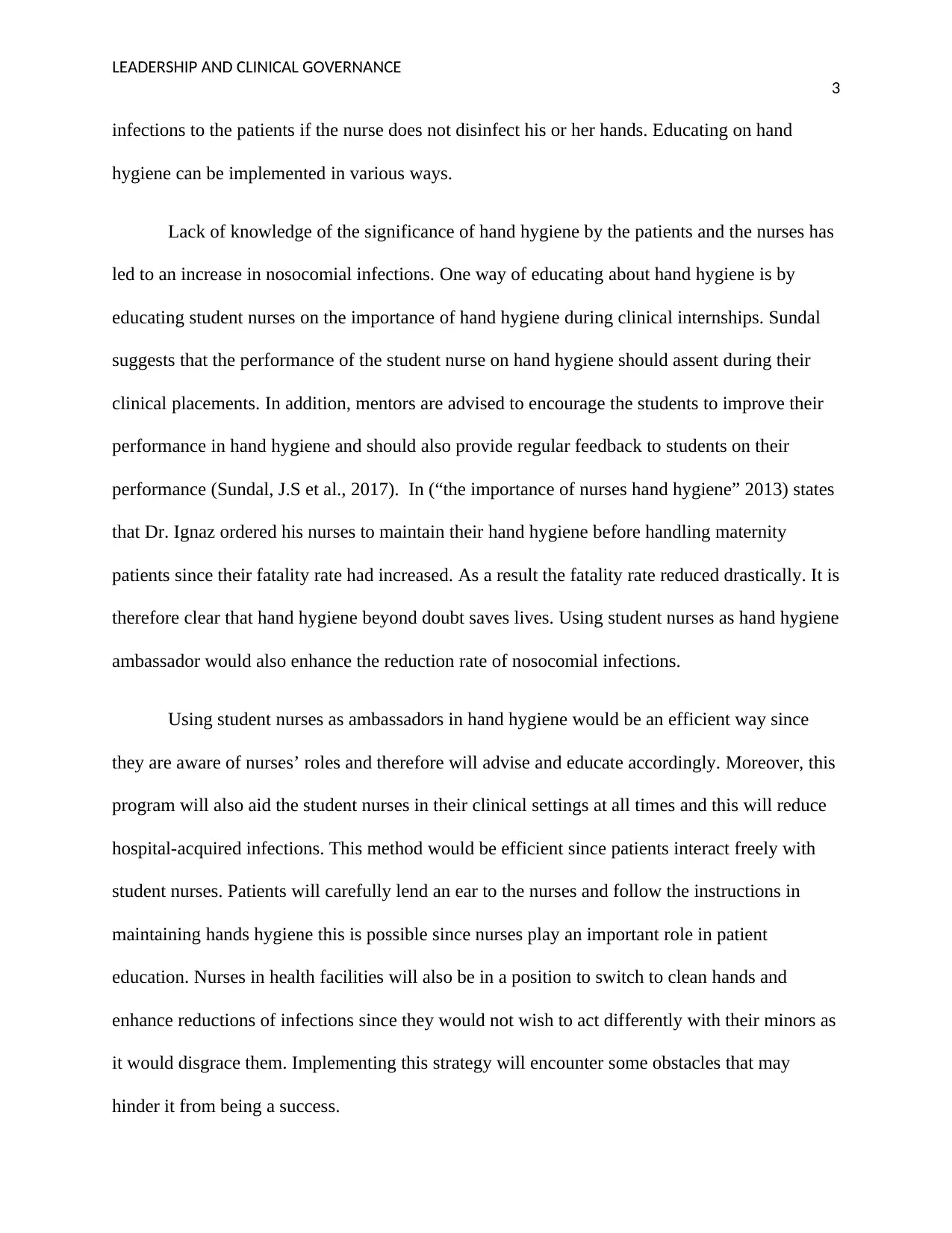
LEADERSHIP AND CLINICAL GOVERNANCE
3
infections to the patients if the nurse does not disinfect his or her hands. Educating on hand
hygiene can be implemented in various ways.
Lack of knowledge of the significance of hand hygiene by the patients and the nurses has
led to an increase in nosocomial infections. One way of educating about hand hygiene is by
educating student nurses on the importance of hand hygiene during clinical internships. Sundal
suggests that the performance of the student nurse on hand hygiene should assent during their
clinical placements. In addition, mentors are advised to encourage the students to improve their
performance in hand hygiene and should also provide regular feedback to students on their
performance (Sundal, J.S et al., 2017). In (“the importance of nurses hand hygiene” 2013) states
that Dr. Ignaz ordered his nurses to maintain their hand hygiene before handling maternity
patients since their fatality rate had increased. As a result the fatality rate reduced drastically. It is
therefore clear that hand hygiene beyond doubt saves lives. Using student nurses as hand hygiene
ambassador would also enhance the reduction rate of nosocomial infections.
Using student nurses as ambassadors in hand hygiene would be an efficient way since
they are aware of nurses’ roles and therefore will advise and educate accordingly. Moreover, this
program will also aid the student nurses in their clinical settings at all times and this will reduce
hospital-acquired infections. This method would be efficient since patients interact freely with
student nurses. Patients will carefully lend an ear to the nurses and follow the instructions in
maintaining hands hygiene this is possible since nurses play an important role in patient
education. Nurses in health facilities will also be in a position to switch to clean hands and
enhance reductions of infections since they would not wish to act differently with their minors as
it would disgrace them. Implementing this strategy will encounter some obstacles that may
hinder it from being a success.
3
infections to the patients if the nurse does not disinfect his or her hands. Educating on hand
hygiene can be implemented in various ways.
Lack of knowledge of the significance of hand hygiene by the patients and the nurses has
led to an increase in nosocomial infections. One way of educating about hand hygiene is by
educating student nurses on the importance of hand hygiene during clinical internships. Sundal
suggests that the performance of the student nurse on hand hygiene should assent during their
clinical placements. In addition, mentors are advised to encourage the students to improve their
performance in hand hygiene and should also provide regular feedback to students on their
performance (Sundal, J.S et al., 2017). In (“the importance of nurses hand hygiene” 2013) states
that Dr. Ignaz ordered his nurses to maintain their hand hygiene before handling maternity
patients since their fatality rate had increased. As a result the fatality rate reduced drastically. It is
therefore clear that hand hygiene beyond doubt saves lives. Using student nurses as hand hygiene
ambassador would also enhance the reduction rate of nosocomial infections.
Using student nurses as ambassadors in hand hygiene would be an efficient way since
they are aware of nurses’ roles and therefore will advise and educate accordingly. Moreover, this
program will also aid the student nurses in their clinical settings at all times and this will reduce
hospital-acquired infections. This method would be efficient since patients interact freely with
student nurses. Patients will carefully lend an ear to the nurses and follow the instructions in
maintaining hands hygiene this is possible since nurses play an important role in patient
education. Nurses in health facilities will also be in a position to switch to clean hands and
enhance reductions of infections since they would not wish to act differently with their minors as
it would disgrace them. Implementing this strategy will encounter some obstacles that may
hinder it from being a success.
⊘ This is a preview!⊘
Do you want full access?
Subscribe today to unlock all pages.

Trusted by 1+ million students worldwide
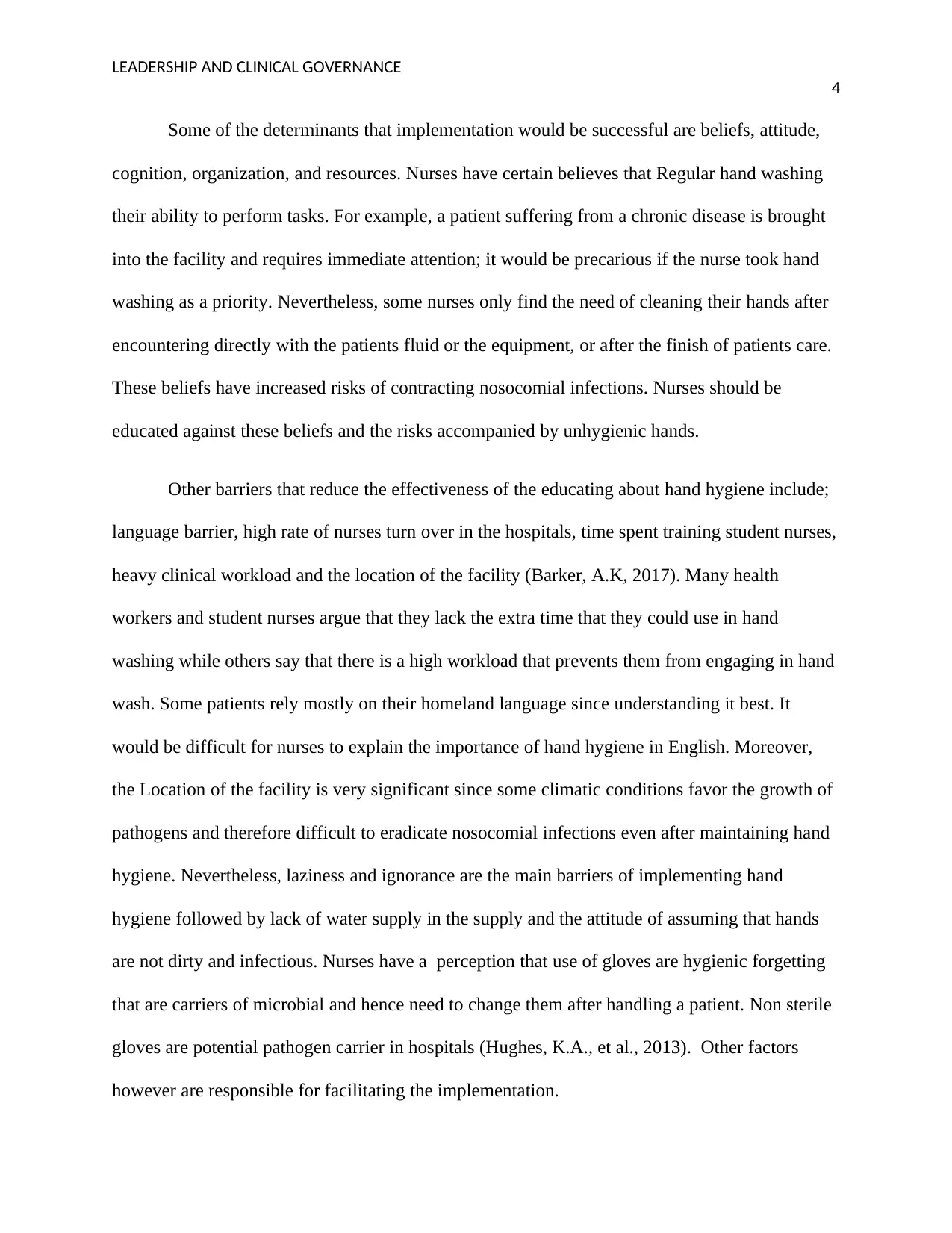
LEADERSHIP AND CLINICAL GOVERNANCE
4
Some of the determinants that implementation would be successful are beliefs, attitude,
cognition, organization, and resources. Nurses have certain believes that Regular hand washing
their ability to perform tasks. For example, a patient suffering from a chronic disease is brought
into the facility and requires immediate attention; it would be precarious if the nurse took hand
washing as a priority. Nevertheless, some nurses only find the need of cleaning their hands after
encountering directly with the patients fluid or the equipment, or after the finish of patients care.
These beliefs have increased risks of contracting nosocomial infections. Nurses should be
educated against these beliefs and the risks accompanied by unhygienic hands.
Other barriers that reduce the effectiveness of the educating about hand hygiene include;
language barrier, high rate of nurses turn over in the hospitals, time spent training student nurses,
heavy clinical workload and the location of the facility (Barker, A.K, 2017). Many health
workers and student nurses argue that they lack the extra time that they could use in hand
washing while others say that there is a high workload that prevents them from engaging in hand
wash. Some patients rely mostly on their homeland language since understanding it best. It
would be difficult for nurses to explain the importance of hand hygiene in English. Moreover,
the Location of the facility is very significant since some climatic conditions favor the growth of
pathogens and therefore difficult to eradicate nosocomial infections even after maintaining hand
hygiene. Nevertheless, laziness and ignorance are the main barriers of implementing hand
hygiene followed by lack of water supply in the supply and the attitude of assuming that hands
are not dirty and infectious. Nurses have a perception that use of gloves are hygienic forgetting
that are carriers of microbial and hence need to change them after handling a patient. Non sterile
gloves are potential pathogen carrier in hospitals (Hughes, K.A., et al., 2013). Other factors
however are responsible for facilitating the implementation.
4
Some of the determinants that implementation would be successful are beliefs, attitude,
cognition, organization, and resources. Nurses have certain believes that Regular hand washing
their ability to perform tasks. For example, a patient suffering from a chronic disease is brought
into the facility and requires immediate attention; it would be precarious if the nurse took hand
washing as a priority. Nevertheless, some nurses only find the need of cleaning their hands after
encountering directly with the patients fluid or the equipment, or after the finish of patients care.
These beliefs have increased risks of contracting nosocomial infections. Nurses should be
educated against these beliefs and the risks accompanied by unhygienic hands.
Other barriers that reduce the effectiveness of the educating about hand hygiene include;
language barrier, high rate of nurses turn over in the hospitals, time spent training student nurses,
heavy clinical workload and the location of the facility (Barker, A.K, 2017). Many health
workers and student nurses argue that they lack the extra time that they could use in hand
washing while others say that there is a high workload that prevents them from engaging in hand
wash. Some patients rely mostly on their homeland language since understanding it best. It
would be difficult for nurses to explain the importance of hand hygiene in English. Moreover,
the Location of the facility is very significant since some climatic conditions favor the growth of
pathogens and therefore difficult to eradicate nosocomial infections even after maintaining hand
hygiene. Nevertheless, laziness and ignorance are the main barriers of implementing hand
hygiene followed by lack of water supply in the supply and the attitude of assuming that hands
are not dirty and infectious. Nurses have a perception that use of gloves are hygienic forgetting
that are carriers of microbial and hence need to change them after handling a patient. Non sterile
gloves are potential pathogen carrier in hospitals (Hughes, K.A., et al., 2013). Other factors
however are responsible for facilitating the implementation.
Paraphrase This Document
Need a fresh take? Get an instant paraphrase of this document with our AI Paraphraser
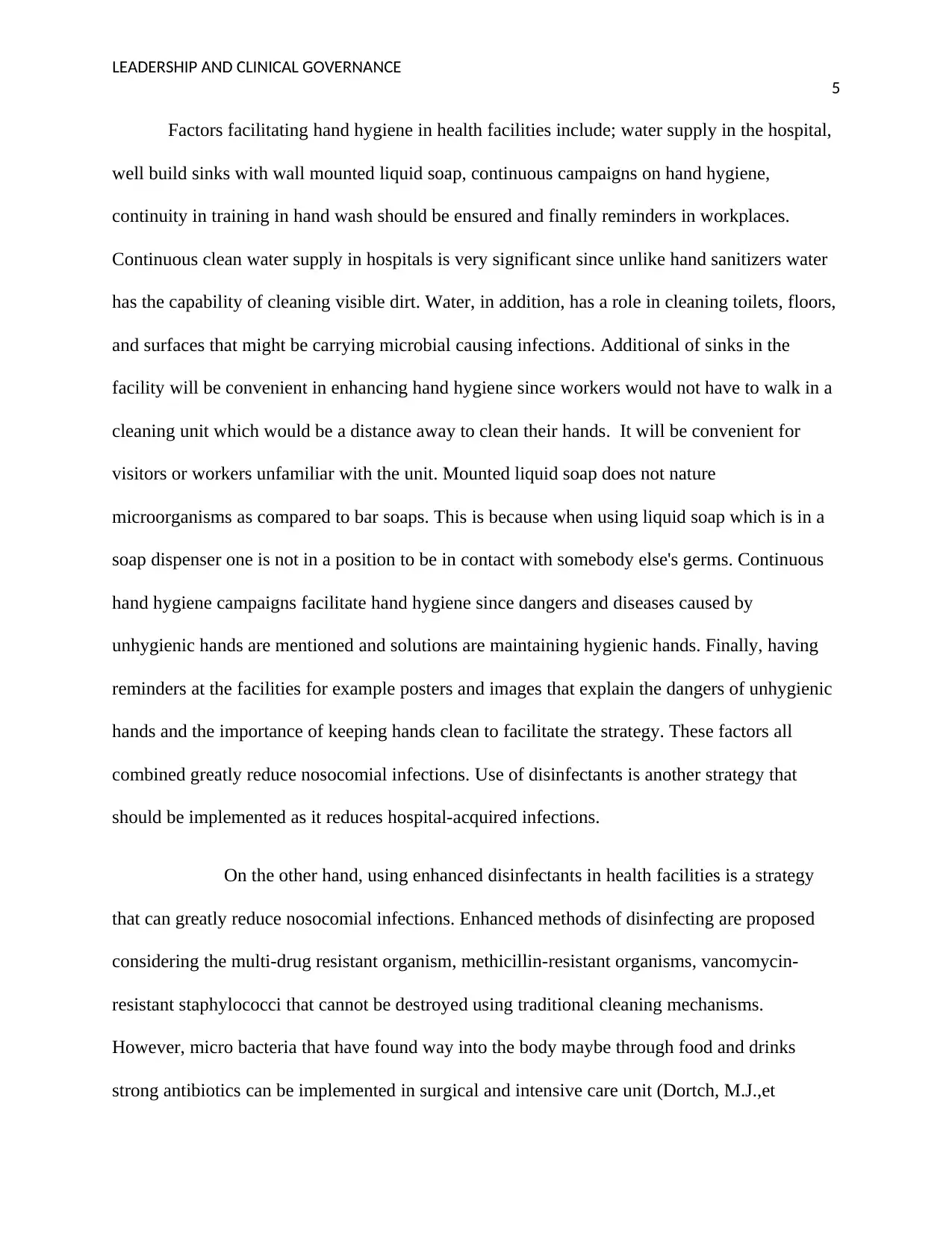
LEADERSHIP AND CLINICAL GOVERNANCE
5
Factors facilitating hand hygiene in health facilities include; water supply in the hospital,
well build sinks with wall mounted liquid soap, continuous campaigns on hand hygiene,
continuity in training in hand wash should be ensured and finally reminders in workplaces.
Continuous clean water supply in hospitals is very significant since unlike hand sanitizers water
has the capability of cleaning visible dirt. Water, in addition, has a role in cleaning toilets, floors,
and surfaces that might be carrying microbial causing infections. Additional of sinks in the
facility will be convenient in enhancing hand hygiene since workers would not have to walk in a
cleaning unit which would be a distance away to clean their hands. It will be convenient for
visitors or workers unfamiliar with the unit. Mounted liquid soap does not nature
microorganisms as compared to bar soaps. This is because when using liquid soap which is in a
soap dispenser one is not in a position to be in contact with somebody else's germs. Continuous
hand hygiene campaigns facilitate hand hygiene since dangers and diseases caused by
unhygienic hands are mentioned and solutions are maintaining hygienic hands. Finally, having
reminders at the facilities for example posters and images that explain the dangers of unhygienic
hands and the importance of keeping hands clean to facilitate the strategy. These factors all
combined greatly reduce nosocomial infections. Use of disinfectants is another strategy that
should be implemented as it reduces hospital-acquired infections.
On the other hand, using enhanced disinfectants in health facilities is a strategy
that can greatly reduce nosocomial infections. Enhanced methods of disinfecting are proposed
considering the multi-drug resistant organism, methicillin-resistant organisms, vancomycin-
resistant staphylococci that cannot be destroyed using traditional cleaning mechanisms.
However, micro bacteria that have found way into the body maybe through food and drinks
strong antibiotics can be implemented in surgical and intensive care unit (Dortch, M.J.,et
5
Factors facilitating hand hygiene in health facilities include; water supply in the hospital,
well build sinks with wall mounted liquid soap, continuous campaigns on hand hygiene,
continuity in training in hand wash should be ensured and finally reminders in workplaces.
Continuous clean water supply in hospitals is very significant since unlike hand sanitizers water
has the capability of cleaning visible dirt. Water, in addition, has a role in cleaning toilets, floors,
and surfaces that might be carrying microbial causing infections. Additional of sinks in the
facility will be convenient in enhancing hand hygiene since workers would not have to walk in a
cleaning unit which would be a distance away to clean their hands. It will be convenient for
visitors or workers unfamiliar with the unit. Mounted liquid soap does not nature
microorganisms as compared to bar soaps. This is because when using liquid soap which is in a
soap dispenser one is not in a position to be in contact with somebody else's germs. Continuous
hand hygiene campaigns facilitate hand hygiene since dangers and diseases caused by
unhygienic hands are mentioned and solutions are maintaining hygienic hands. Finally, having
reminders at the facilities for example posters and images that explain the dangers of unhygienic
hands and the importance of keeping hands clean to facilitate the strategy. These factors all
combined greatly reduce nosocomial infections. Use of disinfectants is another strategy that
should be implemented as it reduces hospital-acquired infections.
On the other hand, using enhanced disinfectants in health facilities is a strategy
that can greatly reduce nosocomial infections. Enhanced methods of disinfecting are proposed
considering the multi-drug resistant organism, methicillin-resistant organisms, vancomycin-
resistant staphylococci that cannot be destroyed using traditional cleaning mechanisms.
However, micro bacteria that have found way into the body maybe through food and drinks
strong antibiotics can be implemented in surgical and intensive care unit (Dortch, M.J.,et
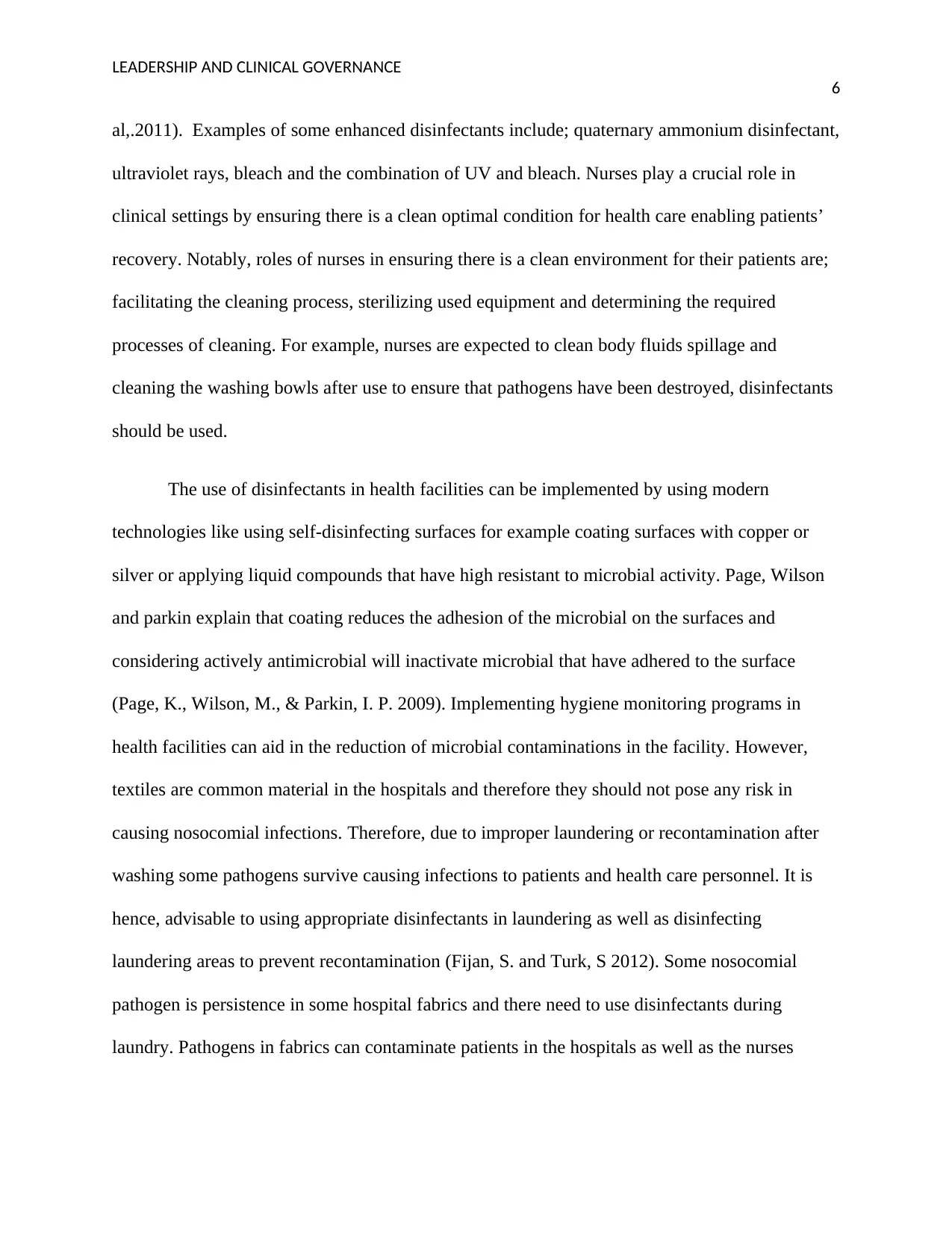
LEADERSHIP AND CLINICAL GOVERNANCE
6
al,.2011). Examples of some enhanced disinfectants include; quaternary ammonium disinfectant,
ultraviolet rays, bleach and the combination of UV and bleach. Nurses play a crucial role in
clinical settings by ensuring there is a clean optimal condition for health care enabling patients’
recovery. Notably, roles of nurses in ensuring there is a clean environment for their patients are;
facilitating the cleaning process, sterilizing used equipment and determining the required
processes of cleaning. For example, nurses are expected to clean body fluids spillage and
cleaning the washing bowls after use to ensure that pathogens have been destroyed, disinfectants
should be used.
The use of disinfectants in health facilities can be implemented by using modern
technologies like using self-disinfecting surfaces for example coating surfaces with copper or
silver or applying liquid compounds that have high resistant to microbial activity. Page, Wilson
and parkin explain that coating reduces the adhesion of the microbial on the surfaces and
considering actively antimicrobial will inactivate microbial that have adhered to the surface
(Page, K., Wilson, M., & Parkin, I. P. 2009). Implementing hygiene monitoring programs in
health facilities can aid in the reduction of microbial contaminations in the facility. However,
textiles are common material in the hospitals and therefore they should not pose any risk in
causing nosocomial infections. Therefore, due to improper laundering or recontamination after
washing some pathogens survive causing infections to patients and health care personnel. It is
hence, advisable to using appropriate disinfectants in laundering as well as disinfecting
laundering areas to prevent recontamination (Fijan, S. and Turk, S 2012). Some nosocomial
pathogen is persistence in some hospital fabrics and there need to use disinfectants during
laundry. Pathogens in fabrics can contaminate patients in the hospitals as well as the nurses
6
al,.2011). Examples of some enhanced disinfectants include; quaternary ammonium disinfectant,
ultraviolet rays, bleach and the combination of UV and bleach. Nurses play a crucial role in
clinical settings by ensuring there is a clean optimal condition for health care enabling patients’
recovery. Notably, roles of nurses in ensuring there is a clean environment for their patients are;
facilitating the cleaning process, sterilizing used equipment and determining the required
processes of cleaning. For example, nurses are expected to clean body fluids spillage and
cleaning the washing bowls after use to ensure that pathogens have been destroyed, disinfectants
should be used.
The use of disinfectants in health facilities can be implemented by using modern
technologies like using self-disinfecting surfaces for example coating surfaces with copper or
silver or applying liquid compounds that have high resistant to microbial activity. Page, Wilson
and parkin explain that coating reduces the adhesion of the microbial on the surfaces and
considering actively antimicrobial will inactivate microbial that have adhered to the surface
(Page, K., Wilson, M., & Parkin, I. P. 2009). Implementing hygiene monitoring programs in
health facilities can aid in the reduction of microbial contaminations in the facility. However,
textiles are common material in the hospitals and therefore they should not pose any risk in
causing nosocomial infections. Therefore, due to improper laundering or recontamination after
washing some pathogens survive causing infections to patients and health care personnel. It is
hence, advisable to using appropriate disinfectants in laundering as well as disinfecting
laundering areas to prevent recontamination (Fijan, S. and Turk, S 2012). Some nosocomial
pathogen is persistence in some hospital fabrics and there need to use disinfectants during
laundry. Pathogens in fabrics can contaminate patients in the hospitals as well as the nurses
⊘ This is a preview!⊘
Do you want full access?
Subscribe today to unlock all pages.

Trusted by 1+ million students worldwide
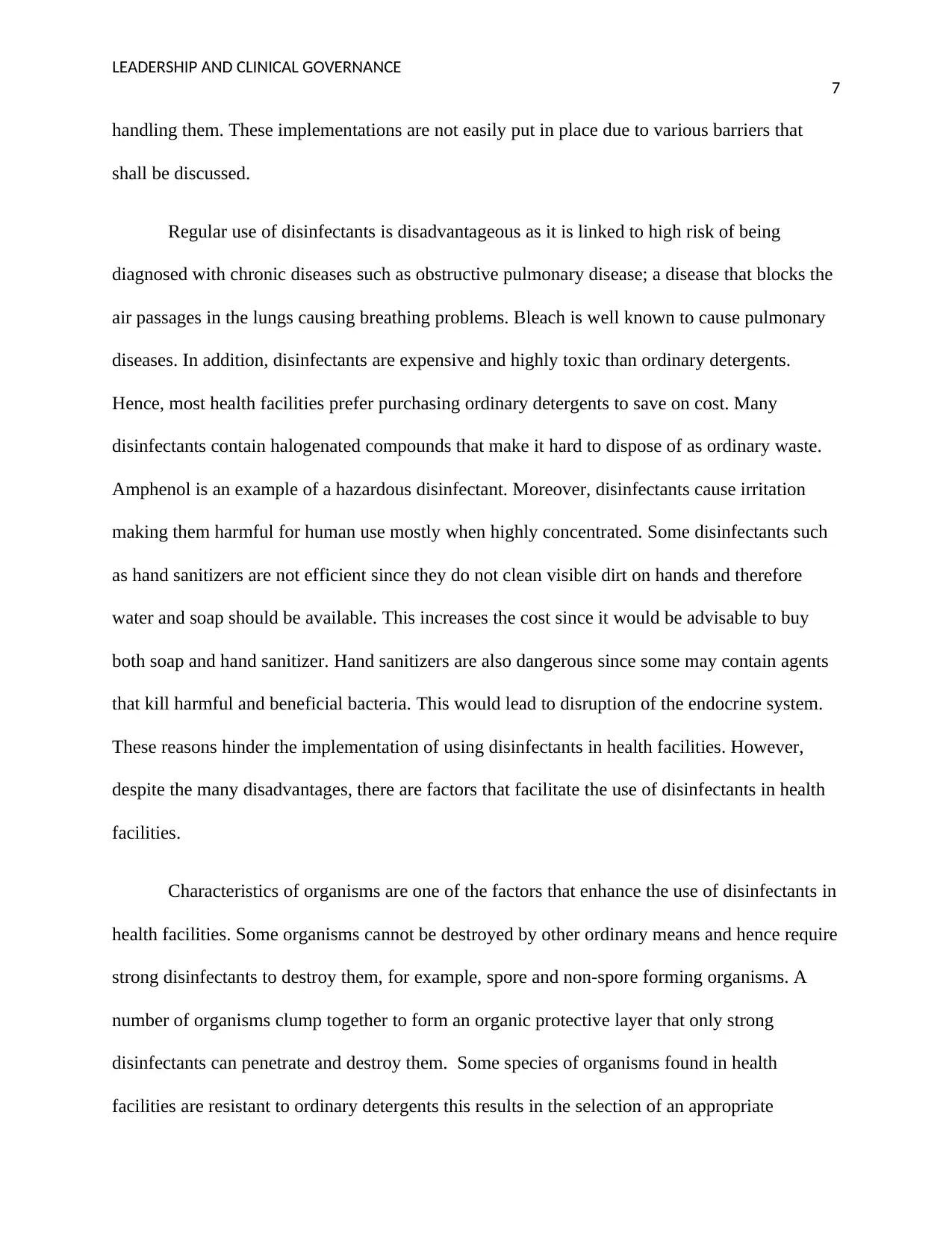
LEADERSHIP AND CLINICAL GOVERNANCE
7
handling them. These implementations are not easily put in place due to various barriers that
shall be discussed.
Regular use of disinfectants is disadvantageous as it is linked to high risk of being
diagnosed with chronic diseases such as obstructive pulmonary disease; a disease that blocks the
air passages in the lungs causing breathing problems. Bleach is well known to cause pulmonary
diseases. In addition, disinfectants are expensive and highly toxic than ordinary detergents.
Hence, most health facilities prefer purchasing ordinary detergents to save on cost. Many
disinfectants contain halogenated compounds that make it hard to dispose of as ordinary waste.
Amphenol is an example of a hazardous disinfectant. Moreover, disinfectants cause irritation
making them harmful for human use mostly when highly concentrated. Some disinfectants such
as hand sanitizers are not efficient since they do not clean visible dirt on hands and therefore
water and soap should be available. This increases the cost since it would be advisable to buy
both soap and hand sanitizer. Hand sanitizers are also dangerous since some may contain agents
that kill harmful and beneficial bacteria. This would lead to disruption of the endocrine system.
These reasons hinder the implementation of using disinfectants in health facilities. However,
despite the many disadvantages, there are factors that facilitate the use of disinfectants in health
facilities.
Characteristics of organisms are one of the factors that enhance the use of disinfectants in
health facilities. Some organisms cannot be destroyed by other ordinary means and hence require
strong disinfectants to destroy them, for example, spore and non-spore forming organisms. A
number of organisms clump together to form an organic protective layer that only strong
disinfectants can penetrate and destroy them. Some species of organisms found in health
facilities are resistant to ordinary detergents this results in the selection of an appropriate
7
handling them. These implementations are not easily put in place due to various barriers that
shall be discussed.
Regular use of disinfectants is disadvantageous as it is linked to high risk of being
diagnosed with chronic diseases such as obstructive pulmonary disease; a disease that blocks the
air passages in the lungs causing breathing problems. Bleach is well known to cause pulmonary
diseases. In addition, disinfectants are expensive and highly toxic than ordinary detergents.
Hence, most health facilities prefer purchasing ordinary detergents to save on cost. Many
disinfectants contain halogenated compounds that make it hard to dispose of as ordinary waste.
Amphenol is an example of a hazardous disinfectant. Moreover, disinfectants cause irritation
making them harmful for human use mostly when highly concentrated. Some disinfectants such
as hand sanitizers are not efficient since they do not clean visible dirt on hands and therefore
water and soap should be available. This increases the cost since it would be advisable to buy
both soap and hand sanitizer. Hand sanitizers are also dangerous since some may contain agents
that kill harmful and beneficial bacteria. This would lead to disruption of the endocrine system.
These reasons hinder the implementation of using disinfectants in health facilities. However,
despite the many disadvantages, there are factors that facilitate the use of disinfectants in health
facilities.
Characteristics of organisms are one of the factors that enhance the use of disinfectants in
health facilities. Some organisms cannot be destroyed by other ordinary means and hence require
strong disinfectants to destroy them, for example, spore and non-spore forming organisms. A
number of organisms clump together to form an organic protective layer that only strong
disinfectants can penetrate and destroy them. Some species of organisms found in health
facilities are resistant to ordinary detergents this results in the selection of an appropriate
Paraphrase This Document
Need a fresh take? Get an instant paraphrase of this document with our AI Paraphraser
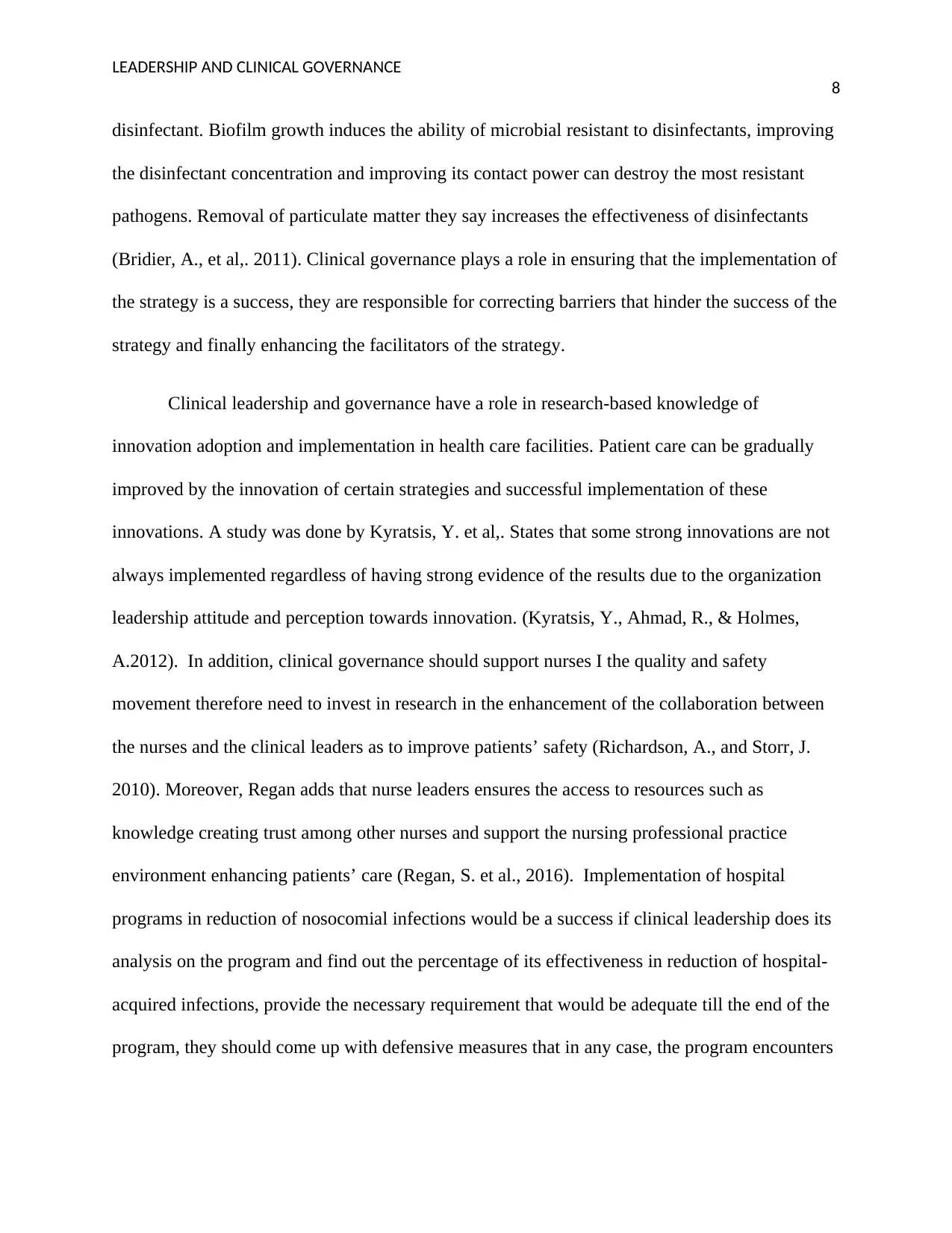
LEADERSHIP AND CLINICAL GOVERNANCE
8
disinfectant. Biofilm growth induces the ability of microbial resistant to disinfectants, improving
the disinfectant concentration and improving its contact power can destroy the most resistant
pathogens. Removal of particulate matter they say increases the effectiveness of disinfectants
(Bridier, A., et al,. 2011). Clinical governance plays a role in ensuring that the implementation of
the strategy is a success, they are responsible for correcting barriers that hinder the success of the
strategy and finally enhancing the facilitators of the strategy.
Clinical leadership and governance have a role in research-based knowledge of
innovation adoption and implementation in health care facilities. Patient care can be gradually
improved by the innovation of certain strategies and successful implementation of these
innovations. A study was done by Kyratsis, Y. et al,. States that some strong innovations are not
always implemented regardless of having strong evidence of the results due to the organization
leadership attitude and perception towards innovation. (Kyratsis, Y., Ahmad, R., & Holmes,
A.2012). In addition, clinical governance should support nurses I the quality and safety
movement therefore need to invest in research in the enhancement of the collaboration between
the nurses and the clinical leaders as to improve patients’ safety (Richardson, A., and Storr, J.
2010). Moreover, Regan adds that nurse leaders ensures the access to resources such as
knowledge creating trust among other nurses and support the nursing professional practice
environment enhancing patients’ care (Regan, S. et al., 2016). Implementation of hospital
programs in reduction of nosocomial infections would be a success if clinical leadership does its
analysis on the program and find out the percentage of its effectiveness in reduction of hospital-
acquired infections, provide the necessary requirement that would be adequate till the end of the
program, they should come up with defensive measures that in any case, the program encounters
8
disinfectant. Biofilm growth induces the ability of microbial resistant to disinfectants, improving
the disinfectant concentration and improving its contact power can destroy the most resistant
pathogens. Removal of particulate matter they say increases the effectiveness of disinfectants
(Bridier, A., et al,. 2011). Clinical governance plays a role in ensuring that the implementation of
the strategy is a success, they are responsible for correcting barriers that hinder the success of the
strategy and finally enhancing the facilitators of the strategy.
Clinical leadership and governance have a role in research-based knowledge of
innovation adoption and implementation in health care facilities. Patient care can be gradually
improved by the innovation of certain strategies and successful implementation of these
innovations. A study was done by Kyratsis, Y. et al,. States that some strong innovations are not
always implemented regardless of having strong evidence of the results due to the organization
leadership attitude and perception towards innovation. (Kyratsis, Y., Ahmad, R., & Holmes,
A.2012). In addition, clinical governance should support nurses I the quality and safety
movement therefore need to invest in research in the enhancement of the collaboration between
the nurses and the clinical leaders as to improve patients’ safety (Richardson, A., and Storr, J.
2010). Moreover, Regan adds that nurse leaders ensures the access to resources such as
knowledge creating trust among other nurses and support the nursing professional practice
environment enhancing patients’ care (Regan, S. et al., 2016). Implementation of hospital
programs in reduction of nosocomial infections would be a success if clinical leadership does its
analysis on the program and find out the percentage of its effectiveness in reduction of hospital-
acquired infections, provide the necessary requirement that would be adequate till the end of the
program, they should come up with defensive measures that in any case, the program encounters
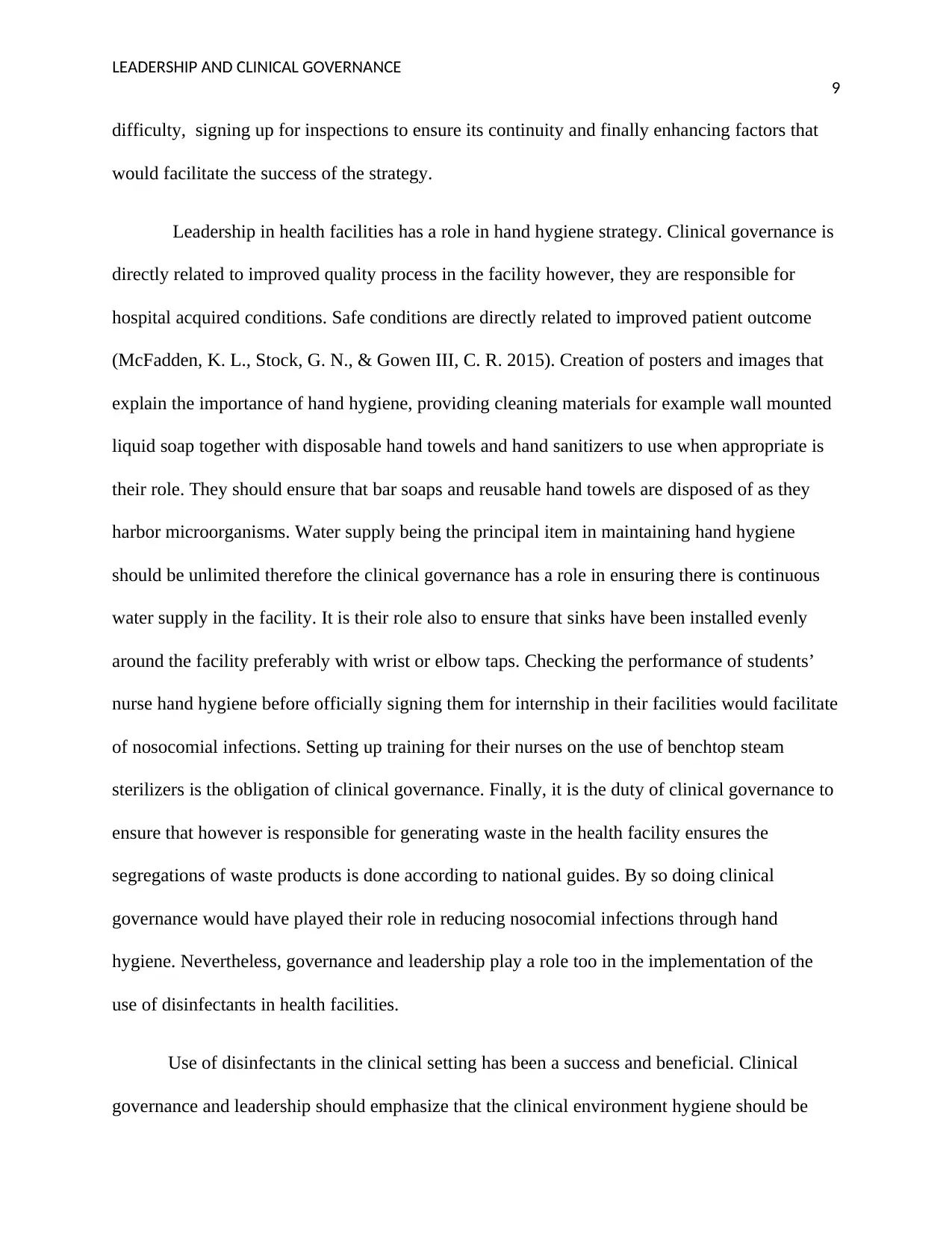
LEADERSHIP AND CLINICAL GOVERNANCE
9
difficulty, signing up for inspections to ensure its continuity and finally enhancing factors that
would facilitate the success of the strategy.
Leadership in health facilities has a role in hand hygiene strategy. Clinical governance is
directly related to improved quality process in the facility however, they are responsible for
hospital acquired conditions. Safe conditions are directly related to improved patient outcome
(McFadden, K. L., Stock, G. N., & Gowen III, C. R. 2015). Creation of posters and images that
explain the importance of hand hygiene, providing cleaning materials for example wall mounted
liquid soap together with disposable hand towels and hand sanitizers to use when appropriate is
their role. They should ensure that bar soaps and reusable hand towels are disposed of as they
harbor microorganisms. Water supply being the principal item in maintaining hand hygiene
should be unlimited therefore the clinical governance has a role in ensuring there is continuous
water supply in the facility. It is their role also to ensure that sinks have been installed evenly
around the facility preferably with wrist or elbow taps. Checking the performance of students’
nurse hand hygiene before officially signing them for internship in their facilities would facilitate
of nosocomial infections. Setting up training for their nurses on the use of benchtop steam
sterilizers is the obligation of clinical governance. Finally, it is the duty of clinical governance to
ensure that however is responsible for generating waste in the health facility ensures the
segregations of waste products is done according to national guides. By so doing clinical
governance would have played their role in reducing nosocomial infections through hand
hygiene. Nevertheless, governance and leadership play a role too in the implementation of the
use of disinfectants in health facilities.
Use of disinfectants in the clinical setting has been a success and beneficial. Clinical
governance and leadership should emphasize that the clinical environment hygiene should be
9
difficulty, signing up for inspections to ensure its continuity and finally enhancing factors that
would facilitate the success of the strategy.
Leadership in health facilities has a role in hand hygiene strategy. Clinical governance is
directly related to improved quality process in the facility however, they are responsible for
hospital acquired conditions. Safe conditions are directly related to improved patient outcome
(McFadden, K. L., Stock, G. N., & Gowen III, C. R. 2015). Creation of posters and images that
explain the importance of hand hygiene, providing cleaning materials for example wall mounted
liquid soap together with disposable hand towels and hand sanitizers to use when appropriate is
their role. They should ensure that bar soaps and reusable hand towels are disposed of as they
harbor microorganisms. Water supply being the principal item in maintaining hand hygiene
should be unlimited therefore the clinical governance has a role in ensuring there is continuous
water supply in the facility. It is their role also to ensure that sinks have been installed evenly
around the facility preferably with wrist or elbow taps. Checking the performance of students’
nurse hand hygiene before officially signing them for internship in their facilities would facilitate
of nosocomial infections. Setting up training for their nurses on the use of benchtop steam
sterilizers is the obligation of clinical governance. Finally, it is the duty of clinical governance to
ensure that however is responsible for generating waste in the health facility ensures the
segregations of waste products is done according to national guides. By so doing clinical
governance would have played their role in reducing nosocomial infections through hand
hygiene. Nevertheless, governance and leadership play a role too in the implementation of the
use of disinfectants in health facilities.
Use of disinfectants in the clinical setting has been a success and beneficial. Clinical
governance and leadership should emphasize that the clinical environment hygiene should be
⊘ This is a preview!⊘
Do you want full access?
Subscribe today to unlock all pages.

Trusted by 1+ million students worldwide

LEADERSHIP AND CLINICAL GOVERNANCE
10
improved to reduce hospital-acquired infections. The governance should invite specialists in
disinfecting procedures field to analyze the level of micro bacterial growth, existence and their
resistance capability and finally advice on the best type of disinfectant that should be used in that
particular clinical setting. Purchasing of these disinfectants should be signed by the clinical
government and ensure that they are never unavailable. Clinical leadership and governance
should set up training for nurses on how to use some of the disinfectants without causing any
physical or internal injury. It is clear that clinical governance and leadership are the backbones of
the maintenance of a high degree of hygiene in clinical health facilities as no action can take
place without their knowledge.
Without any contradiction, it is clear that hygiene is the most important principle in reducing
hospital-acquired infections. Nurses, patients and more importantly clinical governance all play a
role in enhancing a clean and conducive clinical environment.
10
improved to reduce hospital-acquired infections. The governance should invite specialists in
disinfecting procedures field to analyze the level of micro bacterial growth, existence and their
resistance capability and finally advice on the best type of disinfectant that should be used in that
particular clinical setting. Purchasing of these disinfectants should be signed by the clinical
government and ensure that they are never unavailable. Clinical leadership and governance
should set up training for nurses on how to use some of the disinfectants without causing any
physical or internal injury. It is clear that clinical governance and leadership are the backbones of
the maintenance of a high degree of hygiene in clinical health facilities as no action can take
place without their knowledge.
Without any contradiction, it is clear that hygiene is the most important principle in reducing
hospital-acquired infections. Nurses, patients and more importantly clinical governance all play a
role in enhancing a clean and conducive clinical environment.
Paraphrase This Document
Need a fresh take? Get an instant paraphrase of this document with our AI Paraphraser
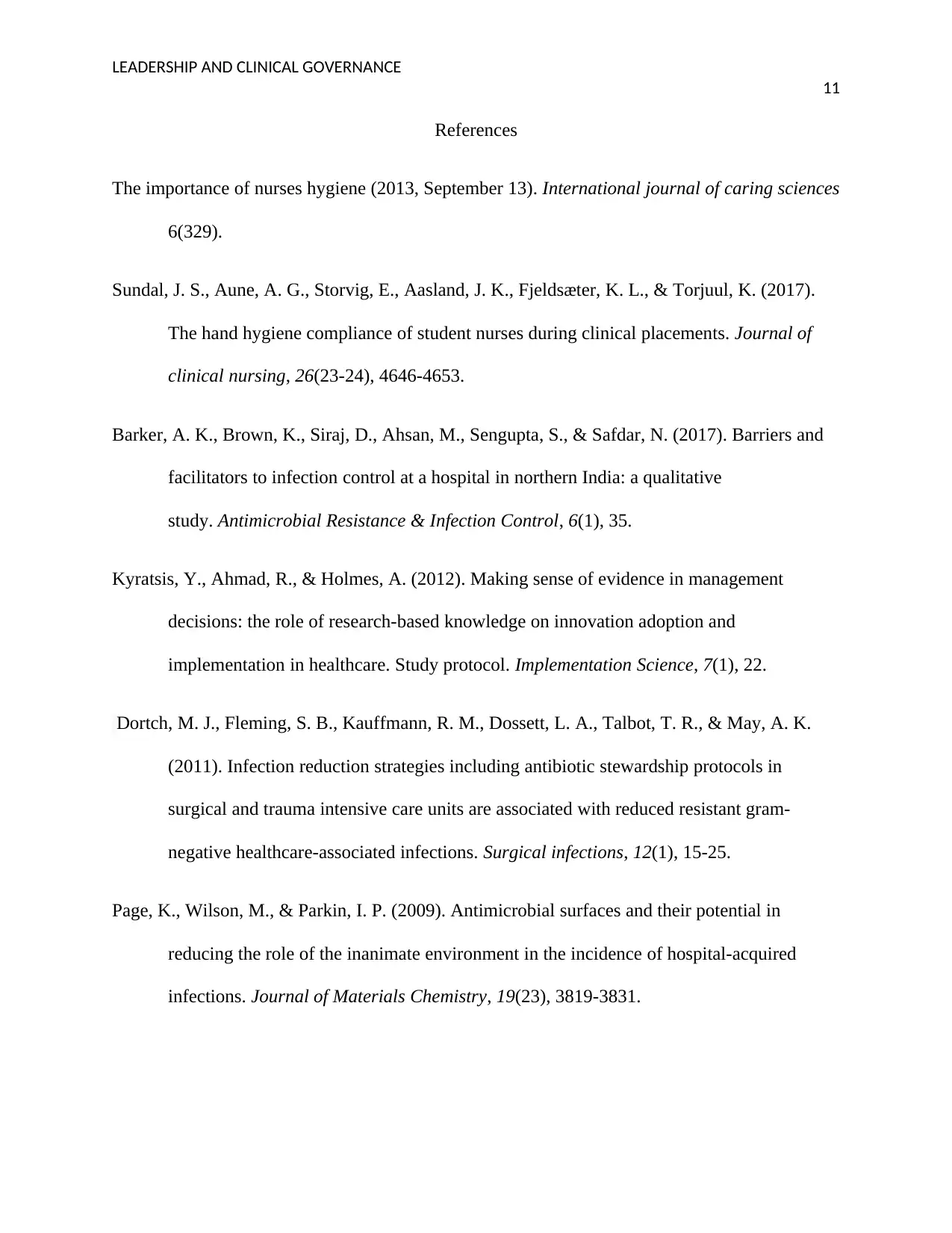
LEADERSHIP AND CLINICAL GOVERNANCE
11
References
The importance of nurses hygiene (2013, September 13). International journal of caring sciences
6(329).
Sundal, J. S., Aune, A. G., Storvig, E., Aasland, J. K., Fjeldsæter, K. L., & Torjuul, K. (2017).
The hand hygiene compliance of student nurses during clinical placements. Journal of
clinical nursing, 26(23-24), 4646-4653.
Barker, A. K., Brown, K., Siraj, D., Ahsan, M., Sengupta, S., & Safdar, N. (2017). Barriers and
facilitators to infection control at a hospital in northern India: a qualitative
study. Antimicrobial Resistance & Infection Control, 6(1), 35.
Kyratsis, Y., Ahmad, R., & Holmes, A. (2012). Making sense of evidence in management
decisions: the role of research-based knowledge on innovation adoption and
implementation in healthcare. Study protocol. Implementation Science, 7(1), 22.
Dortch, M. J., Fleming, S. B., Kauffmann, R. M., Dossett, L. A., Talbot, T. R., & May, A. K.
(2011). Infection reduction strategies including antibiotic stewardship protocols in
surgical and trauma intensive care units are associated with reduced resistant gram-
negative healthcare-associated infections. Surgical infections, 12(1), 15-25.
Page, K., Wilson, M., & Parkin, I. P. (2009). Antimicrobial surfaces and their potential in
reducing the role of the inanimate environment in the incidence of hospital-acquired
infections. Journal of Materials Chemistry, 19(23), 3819-3831.
11
References
The importance of nurses hygiene (2013, September 13). International journal of caring sciences
6(329).
Sundal, J. S., Aune, A. G., Storvig, E., Aasland, J. K., Fjeldsæter, K. L., & Torjuul, K. (2017).
The hand hygiene compliance of student nurses during clinical placements. Journal of
clinical nursing, 26(23-24), 4646-4653.
Barker, A. K., Brown, K., Siraj, D., Ahsan, M., Sengupta, S., & Safdar, N. (2017). Barriers and
facilitators to infection control at a hospital in northern India: a qualitative
study. Antimicrobial Resistance & Infection Control, 6(1), 35.
Kyratsis, Y., Ahmad, R., & Holmes, A. (2012). Making sense of evidence in management
decisions: the role of research-based knowledge on innovation adoption and
implementation in healthcare. Study protocol. Implementation Science, 7(1), 22.
Dortch, M. J., Fleming, S. B., Kauffmann, R. M., Dossett, L. A., Talbot, T. R., & May, A. K.
(2011). Infection reduction strategies including antibiotic stewardship protocols in
surgical and trauma intensive care units are associated with reduced resistant gram-
negative healthcare-associated infections. Surgical infections, 12(1), 15-25.
Page, K., Wilson, M., & Parkin, I. P. (2009). Antimicrobial surfaces and their potential in
reducing the role of the inanimate environment in the incidence of hospital-acquired
infections. Journal of Materials Chemistry, 19(23), 3819-3831.
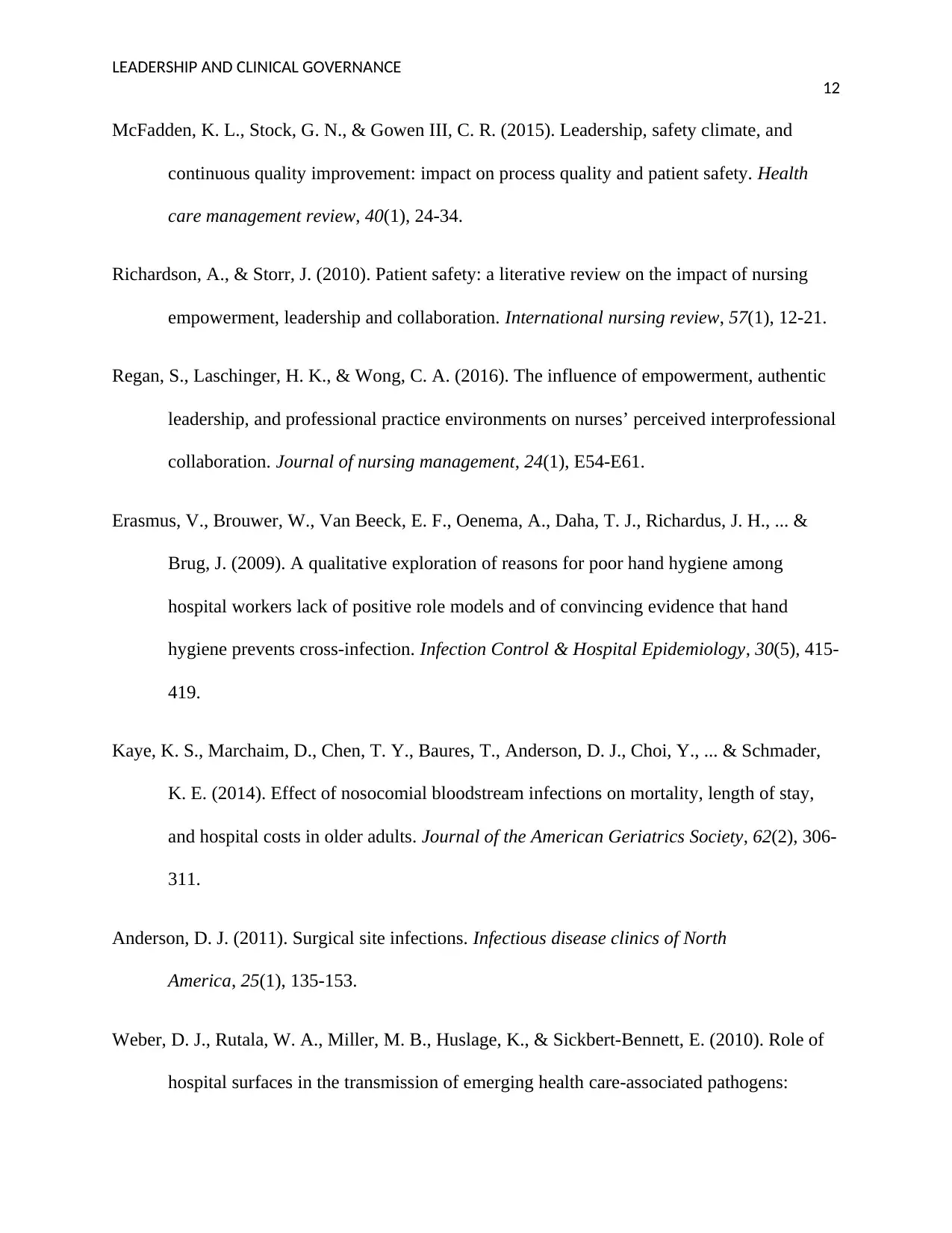
LEADERSHIP AND CLINICAL GOVERNANCE
12
McFadden, K. L., Stock, G. N., & Gowen III, C. R. (2015). Leadership, safety climate, and
continuous quality improvement: impact on process quality and patient safety. Health
care management review, 40(1), 24-34.
Richardson, A., & Storr, J. (2010). Patient safety: a literative review on the impact of nursing
empowerment, leadership and collaboration. International nursing review, 57(1), 12-21.
Regan, S., Laschinger, H. K., & Wong, C. A. (2016). The influence of empowerment, authentic
leadership, and professional practice environments on nurses’ perceived interprofessional
collaboration. Journal of nursing management, 24(1), E54-E61.
Erasmus, V., Brouwer, W., Van Beeck, E. F., Oenema, A., Daha, T. J., Richardus, J. H., ... &
Brug, J. (2009). A qualitative exploration of reasons for poor hand hygiene among
hospital workers lack of positive role models and of convincing evidence that hand
hygiene prevents cross-infection. Infection Control & Hospital Epidemiology, 30(5), 415-
419.
Kaye, K. S., Marchaim, D., Chen, T. Y., Baures, T., Anderson, D. J., Choi, Y., ... & Schmader,
K. E. (2014). Effect of nosocomial bloodstream infections on mortality, length of stay,
and hospital costs in older adults. Journal of the American Geriatrics Society, 62(2), 306-
311.
Anderson, D. J. (2011). Surgical site infections. Infectious disease clinics of North
America, 25(1), 135-153.
Weber, D. J., Rutala, W. A., Miller, M. B., Huslage, K., & Sickbert-Bennett, E. (2010). Role of
hospital surfaces in the transmission of emerging health care-associated pathogens:
12
McFadden, K. L., Stock, G. N., & Gowen III, C. R. (2015). Leadership, safety climate, and
continuous quality improvement: impact on process quality and patient safety. Health
care management review, 40(1), 24-34.
Richardson, A., & Storr, J. (2010). Patient safety: a literative review on the impact of nursing
empowerment, leadership and collaboration. International nursing review, 57(1), 12-21.
Regan, S., Laschinger, H. K., & Wong, C. A. (2016). The influence of empowerment, authentic
leadership, and professional practice environments on nurses’ perceived interprofessional
collaboration. Journal of nursing management, 24(1), E54-E61.
Erasmus, V., Brouwer, W., Van Beeck, E. F., Oenema, A., Daha, T. J., Richardus, J. H., ... &
Brug, J. (2009). A qualitative exploration of reasons for poor hand hygiene among
hospital workers lack of positive role models and of convincing evidence that hand
hygiene prevents cross-infection. Infection Control & Hospital Epidemiology, 30(5), 415-
419.
Kaye, K. S., Marchaim, D., Chen, T. Y., Baures, T., Anderson, D. J., Choi, Y., ... & Schmader,
K. E. (2014). Effect of nosocomial bloodstream infections on mortality, length of stay,
and hospital costs in older adults. Journal of the American Geriatrics Society, 62(2), 306-
311.
Anderson, D. J. (2011). Surgical site infections. Infectious disease clinics of North
America, 25(1), 135-153.
Weber, D. J., Rutala, W. A., Miller, M. B., Huslage, K., & Sickbert-Bennett, E. (2010). Role of
hospital surfaces in the transmission of emerging health care-associated pathogens:
⊘ This is a preview!⊘
Do you want full access?
Subscribe today to unlock all pages.

Trusted by 1+ million students worldwide
1 out of 13
Related Documents
Your All-in-One AI-Powered Toolkit for Academic Success.
+13062052269
info@desklib.com
Available 24*7 on WhatsApp / Email
![[object Object]](/_next/static/media/star-bottom.7253800d.svg)
Unlock your academic potential
Copyright © 2020–2025 A2Z Services. All Rights Reserved. Developed and managed by ZUCOL.





